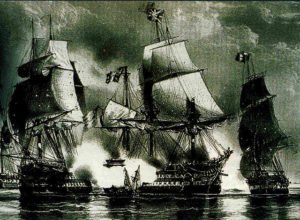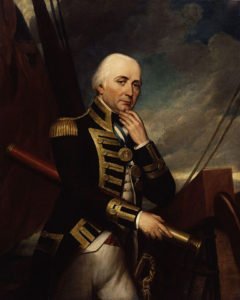John Child Purvis
1747-1825. He was born at Stepney on 13 March 1747, the second son of George Purvis, the secretary to the Sick and Wounded Board, and of his wife Mary Oadham. He was the grandson of Captain George Purvis, the M.P. for Aldeburgh and comptroller of the navy in the 1730’s, and the brother of Captain Richard Purvis who died in May 1802. Another brother, George, served as secretary to Admiral Lord Howe and later to Admiral the Earl of St. Vincent in the Mediterranean.
Purvis first went to sea in 1761 aboard the Arrogant 74, Captain John Amherst, serving off Spain during 1762-3. After the peace and many years of unemployment he was commissioned lieutenant on 11 February 1778 and joined the Invincible 74, Captain Anthony Parrey, flying the broad pennant of Commodore John Evans in Vice-Admiral Hon John Byron’s fleet which sailed for North America on 9 June. After her return home that winter he was appointed in April 1779 to the Britannia 100, Captain Charles Morice Pole, the flagship of Vice-Admiral George Darby in the Channel, and he was present in the retreat of August.
Purvis left the Britannia upon being promoted commander of the captured French privateer Duc de Chartres, which he commissioned as an 18-gun sloop on 9 April 1781, this privateer having been captured by Darby’s fleet whilst on passage to relieve Gibraltar. He sailed for England almost immediately, outrunning two French sail of the line on his passage home, and after a refit at Spithead he departed with a convoy for North America in October. On 19 August 1782 he captured the hired French corvette Aigle 22 off Cape Henry without suffering a single casualty, and accordingly he was posted captain on 1 September. The Duc de Chartres took the privateer Julius Caesar in company with the Vestal 28, Captain William Fox, and Astrea 32, Captain Matthew Squire, on 15 March 1783, but was decommissioned in New York in April with Purvis returning to England and unemployment for the next ten years.
In February 1793 he joined the frigate Amphitrite 28 with orders to commission her at Woolwich, and after sailing to Spithead he transferred to Princess Royal 98 on 5 April, going out to Gibraltar later that month to receive the flag of Rear-Admiral Samuel Granston Goodall. He served with this officer at the occupation of Toulon from 27 August where his ship slugged it out against the battery at La Petite Garenne over several weeks. Continuing in the Princess Royal under Goodall, Purvis was present in the operations against Corsica from February 1794, and fought at the Battle of Genoa on 13-14 March 1795, losing three men killed and eight wounded, and the Battle of the Hyères Islands on 13 July. Following the arrival of the new commander-in-chief, Vice-Admiral Sir John Jervis in December 1795, Purvis received the flag of Vice-Admiral Robert Linzee aboard the Princess Royal, but in May of the following year his command was ordered home with a convoy for Spithead, arriving in August. By 10 November she had been decommissioned and Purvis remained ashore for the next six months.
In May 1797, following the Spithead mutiny which erupted on 16 April, he replaced the deposed Captain Edward Griffith aboard the thirty-year-old London 98, serving initially with the Channel fleet off Ushant. After three months at Spithead from November 1797 until February 1798 he was ordered out to the Tagus with a convoy for the Mediterranean fleet, and he joined Rear-Admiral Sir John Orde’s squadron off Cadiz. He was still with the Mediterranean fleet in the campaign that followed the breakout of the Brest fleet on 25 April 1799, but on returning to Torbay on 16 August his command transferred to the Channel fleet and joined the blockade off Ushant. She was docked at Spithead between the end of October and the middle of January 1800, and then rejoined the Channel fleet, which passed to the command of Admiral Earl of St. Vincent in the spring. During June-August 1800 he commanded the London in Rear-Admiral Sir John Borlase Warren’s expedition to Ferrol before returning to the Ushant blockade.
When the London was appropriated as Admiral Sir Hyde Parker’s flagship for the expedition to the Baltic that would result in the Battle of Copenhagen, Purvis exchanged with Captain Robert Waller Otway into the Royal George 100 on 5 February 1801, and he continued on the blockade off Brest until the latter vessel was paid off at Plymouth on 24 April 1802.
Following the resumption of hostilities Purvis joined the Dreadnought 98 in September 1803, serving once more with the Channel fleet off Ushant and Rochefort until he was advanced to flag rank on 23 April 1804. Having left the Dreadnought at Plymouth in May he remained ashore for the next two years.
In June 1806 he returned to service and went out to the Mediterranean upon being appointed second-in-command to Vice-Admiral Lord Collingwood at that officer’s request. Taking passage with Lieutenant-General Sir John Moore and two other generals aboard the Chiffonne 32, Captain John Wainwright, he arrived off Cape Spartel on 27 June and took his flag aboard the Minotaur 74, Captain Charles Moore Mansfield. He presided over the court-martial which dismissed Captain John Oakes Hardy from the Zealous 74 and the service that September, and on the 22nd of the same month transferred to the Queen 99, Captain Richard Thomas, before on 9 December removing to the Atlas 74, Captains Samuel Pym and James Sanders. Throughout the early part of 1807 he remained with the fleet at sea.
In June 1807 Purvis assumed command of the blockade off Cadiz when Collingwood sailed for the Levant, and with up to ten sail of the line in opposition to the Spanish fleet and five French sail of the line under the command of Vice-Admiral Francois-Etienne de Rosily-Mesros he was praised for keeping his station whatever the weather. His responsibilities changed somewhat in the summer of 1808 when the Spanish rose against their erstwhile French allies following Napoleon’s invasion, although the Spanish refused Purvis’ assistance in the five-day action that saw them take control of the French ships in Cadiz during June. In September he and Collingwood were received ashore by an appreciative city, but the Spanish still did not wish for British assistance, and Purvis instead sailed for Gibraltar where he remained until returning to Cadiz in December out of concern that a French army would arrive to besiege the city.
During the early part of 1809, and despite many frustrations and rejections, he assisted the Spanish patriots in the laborious refitting of their ships and their removal from the port before the French army could arrive. He also had to concern himself with the large number of French prisoners held in distressing conditions on the hulks in Cadiz, men whom Purvis wanted transported away, but over whose future the Spanish prevaricated throughout the whole year. Having just missed out on a promotion the year before, Purvis led the list of officers promoted vice-admiral on 25 October 1809, and shortly afterwards he requested a return home in order to attend to his affairs. In the meantime, Marshal Claude Victor’s army had appeared before Cadiz in early February 1810, whereupon Purvis had finally been allowed to send men ashore to assist in the Spanish defence.
During the spring of 1810 he briefly held the command of the Mediterranean station following the departure of Vice-Admiral Lord Collingwood and the pending the arrival of his replacement, Admiral Sir Charles Cotton. After remaining at Cadiz to await Cotton, and despite having received notification in early April that he could return home, Purvis finally struck his flag on 13 May and sailed back to England aboard the Leda 36, Captain George Sayer.
He did not go afloat thereafter but was advanced to the rank of admiral on 12 August 1819 and retired to his new property at Vicar’s Hill House, Boldre, near Lymington where he died on 23 February 1825, being buried in Boldre Churchyard.
Purvis was married three times. On 11 October 1784 he married Catherine Sowers, daughter of an Admiralty official and the mother of two children who died in infancy before having issue the future Vice-Admiral John Brett Purvis and Rev Richard Fortescue Purvis. She died in 3 February 1789. On 11 March 1790 he married Mary Longhurst Garrett, the sister of the future Vice-Admiral Henry Garrett, by whom he had another son who died in infancy and a daughter, Mary who died at the age of four. Mary Garrett died on 1 July 1798. His third wife, whom he married on 2 August 1804, was Elizabeth, the only daughter and wealthy heiress of Admiral Sir Archibald Dickson, and the thirty-six-year-old widow of an army officer who had died at San Domingo in 1795. He was possibly the natural father of Captain John Scott, who served with him aboard the London, and was left the not inconsiderable sum of £2,000 in Purvis’ will.
In the spring of 1808 his nephew, a lieutenant aboard the Belleisle 74, was dismissed the navy for wounding three French officers aboard a cartel sailing to Martinique. Purvis amassed a great wealth over his career.


